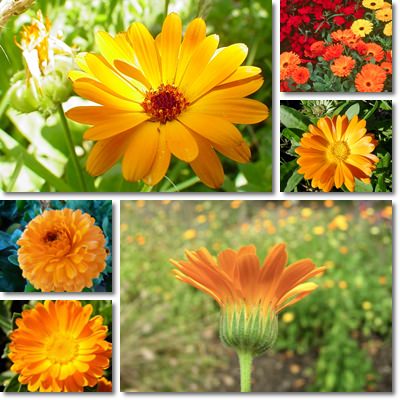The common marigold (Calendula officinalis), also known as calendula is one of 13 calendula species in the Asteraceae family. In addition to being edible, calendula flowers are prized for their potent medicinal properties. Calendula consumption either as food or tea helps expel parasitic worms as a result of the plant’s natural anthelmintic properties and is said to support normal liver function.
Moreover, calendula is particularly soothing on the stomach in the sense that it reduces stomach lining inflammation in gastritis and ulcer sufferers. Its soothing properties are said to benefit the digestive system further down, helping manage hemorrhoid symptoms. When applied externally, calendula is highly efficient against fungal infections, insect bites, even purulent wounds due to its naturally antiseptic and anti-inflammatory properties.

What does calendula look like?
Calendula or pot marigold, also known as English marigold or simply marigold, is the deep yellow-orange variant of the daisy flower. Very often, calendula flowers boast an array of petals disposed on several levels, a feature that makes the flower head much more appealing for gardeners. Calendula as a gardening plant.
Marigold flowers make a great ornamental plant not only because of their beautiful rich colors, but also because they are low-maintenance. Ideally, calendula thrives in sunny climates, but winter frosts and hot climates cause the plants to die out. It makes a great pot plant, hence the name ‘pot marigold’.
What does calendula taste like?
First of all, you should know that it is best to eat only calendula petals. So before you decide to throw the flower in a salad, remember to discard the stamens, pistils, even leaves. Calendula petals range in taste from spicy-peppery to bitter and, to be honest, they aren’t that appetizing. You can add them to soups or even omelets and scrambled eggs, to which they lend a slight yellow color. They also make any salad look pretty dainty.
Calendula petals can either be eaten fresh or dried for herbal infusions. Calendula (marigold) essential oil is efficient against acne and acne scars, promoting clear, radiant skin. The herb can be used both internally and externally. It is important to remember that calendula essential oil is for external use only.

Calendula: internal uses and benefits
For internal use, cover calendula petals with a clean cloth and leave them to dry for about 20 days in a dark, cool place. After the process is complete, put 2 teaspoons of dried petals in a teacup or mug and add 250 ml of boiling water. Cover the teacup or mug for 15-20 minutes and after the infusion is ready, you may filter it. Drink at least a cup of calendula tea a day, preferably on an empty stomach.
Regular use of calendula preparations helps improve conditions such as gastritis, stomach ulcers or inflammatory digestive conditions, and even hemorrhoids when applied topically by reducing inflammation locally.
Moreover, calendula is a great natural anthelmintic, meaning it helps expel intestinal worms. However, if you suspect you are infected with parasitic worms, see your doctor for appropriate treatment; worms and intestinal parasites are extremely stubborn to deal with using natural solutions and only anthelmintic medication can get rid of an infection 100%.
The plant boasts surprising anti-viral and anti-tumor activity as well. Due to its antispasmodic activity, it is highly efficient against abdominal cramps and may help treat constipation.
Last but not least, it is said to promote liver detoxification and encourage liver regeneration.
Calendula: external uses and benefits
For external use: marigold infusion to wash open wounds, burns, ulcers, eyes and face. Infuse 90-100 g of dried petals in 1 liter of water, leave to cool, then use externally.
Calendula has strong antiseptic, anti-fungal and antiviral properties, making it excellent for cleaning purulent wounds. Because it is natural, lacking perfume and other damaging compounds that may alter you natural pH, you can even use calendula as a natural wash.
It is said that washing your face with calendula infusion gives skin a natural glow. Regular use is also said to help clear acne and reduce the severity of acne scars. In the past, people would use marigold poultices to help reduce the severity of smallpox scars.
Being rich in lutein and having antiseptic properties, calendula is also said to alleviate conjunctivitis because it helps reduce inflammation.
You can also apply homemade marigold poultices to burns or use them for treating fungal infections on your skin.
Last but not least, you can use calendula to treat insect bites. Although it doesn’t smell very appealing, calendula essential oil is great for burns, dermatitis, cold sores and psoriasis due to its antiseptic and calming effects.
Calendula flowers are rich in carotenoids, responsible for the rich yellow and orange coloring of the petals.
Carotenoids boast incredible antioxidant activity, making calendula consumption highly beneficial for eye health. Nevertheless, there are some things you should consider when looking to introduce the herb into your diet.
Side effects and contraindications of Calendula
- Only calendula petals are edible. Avoid eating stamens, pistils, leaves, roots and stems.
- Always refrain from eating more than a few petals or, maximum, the petals of one flower head.
- Only use calendula from safe sources such as the supermarket, farmer’s market or, best of all, your own garden.
- Never eat calendula found on roadsides, in parks or fields or even those from your local florist because the plants found in such places are most likely contaminated with pesticides and car exhaustion gases and will make you sick.
- Avoid calendula during pregnancy as there is no certainty it is safe for expecting mothers.
- If you are suffering from allergies to other flowering plants, introduce calendula into your diet gradually and in very small amounts.
If you have an allergy to asteraceae plants (these being plants in the daisy family such as sunflowers, chamomile, Echinacea or tarragon), it might be best to avoid eating calendula until you have a chance to see a doctor and take a skin prick test to rule out the possibility of being allergic to calendula too. This is important because the edible part of the plant, the petals, may be contaminated with pollen and consumption can trigger severe allergic reactions in individuals at risk.
